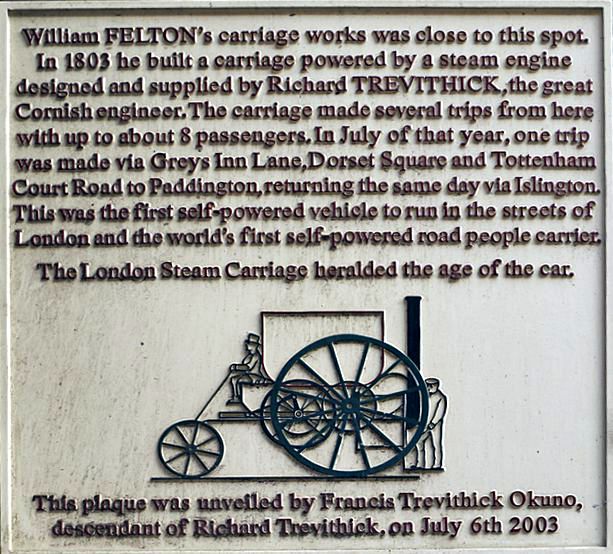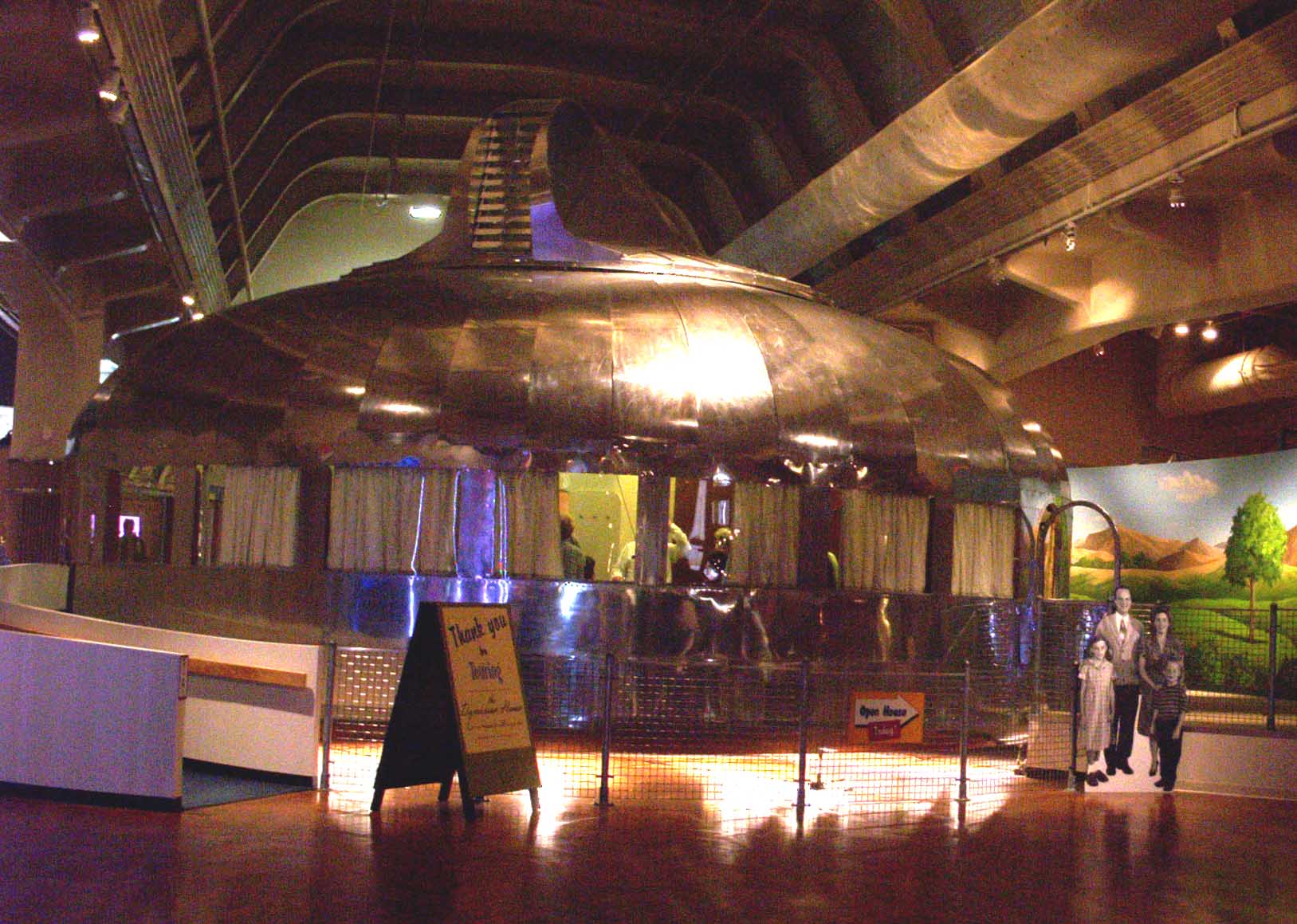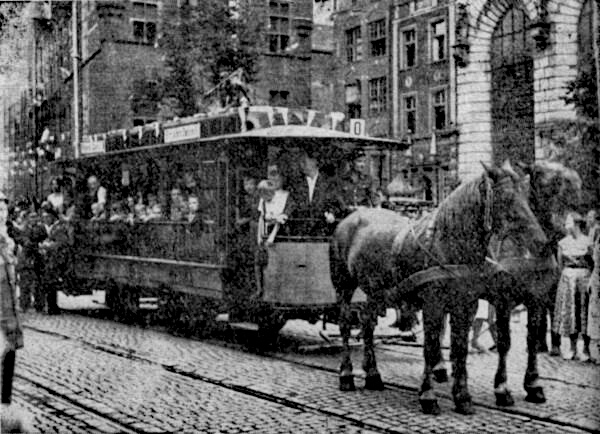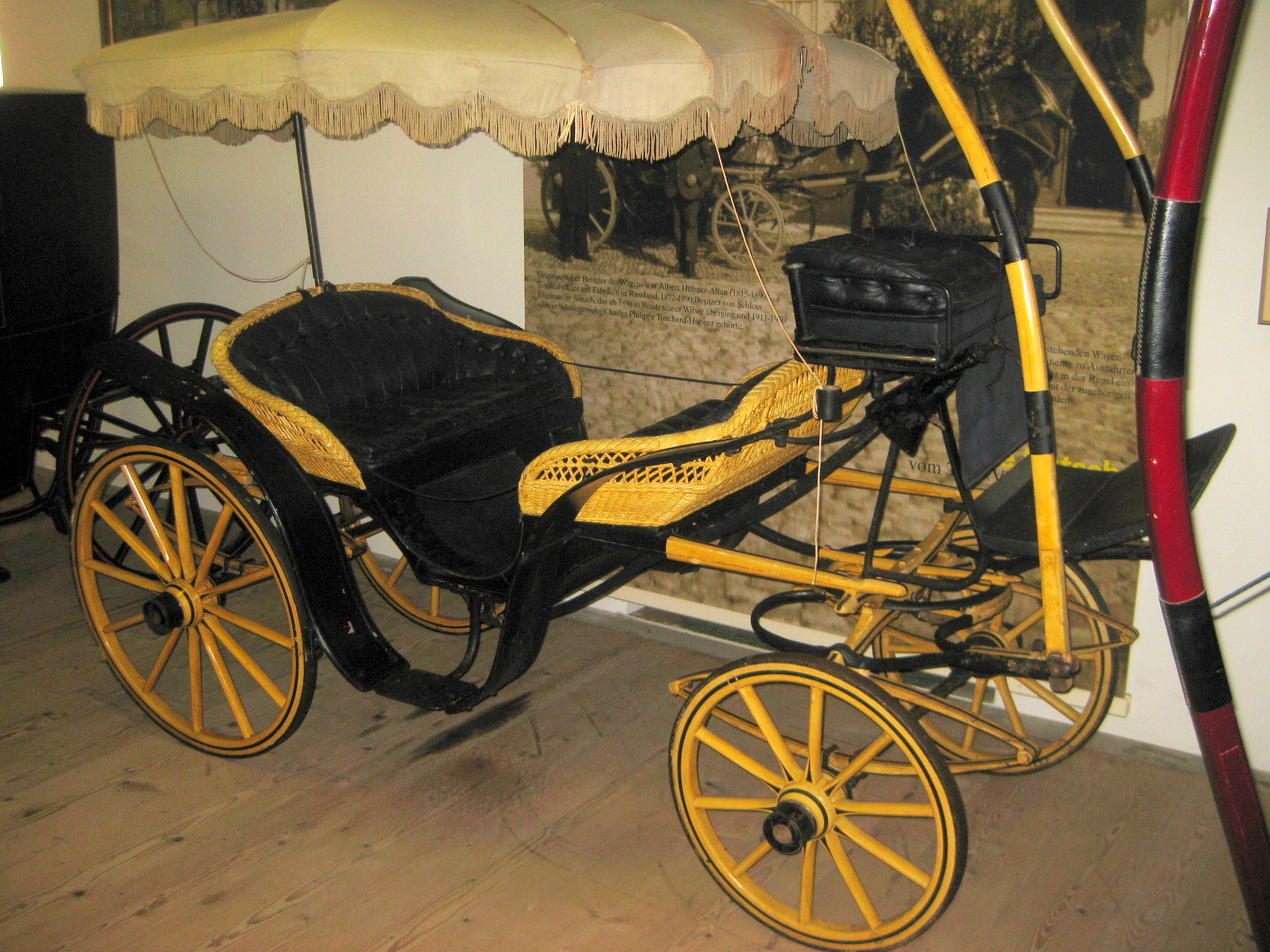|
Amish Buggies
A buggy refers to a lightweight four-wheeled carriage drawn by a single horse, though occasionally by two. Amish buggies are still regularly Equestrian use of roadways, in use on the roadways of America. The word "buggy" has become a generic term for "carriage" in America. Historically, in England a buggy was a two-wheeled vehicle. American buggy A buggy is a four-wheeled American carriage made on a rectangular pattern, the body resembling a shallow box. There is a vertical leather dash with a metal rein rail on top. A single seat for two people is mounted in the middle of the box leaving room behind the seat for luggage. It is suspended by two sideways elliptic springs, one over the front axle and the other over the rear axle. The wheels are near equirotal, with the front wheels slightly smaller than the rear. Its turning radius is large, achieving only a quarter-lock before the front wheels touch the sides of the buggy body. There were many varieties built, such as adding ... [...More Info...] [...Related Items...] OR: [Wikipedia] [Google] [Baidu] |
William Felton (coachmaker)
William Felton was a London coachmaker from 36 Leather Lane in Holborn, and 254 Oxford Street near Grosvenor Square, and noted for his 1796 illustrated two-volume book, ''A Treatise on Carriages; comprehending Coaches, Chariots, Phaetons, Curricles, Gigs, Whiskies, &c Together with their Proper Harness in which the Fair Prices of Every Article are Accurately Stated.'' In the introduction, Felton wrote that he had no literary pretensions, but rather that his aim was to produce an authoritative guide to the construction, maintenance and repair of horse-drawn coaches. The ''Monthly Review'' agreed that it was not a literary masterpiece, but praised it for its encyclopaedic treatment of the subject. ''The Sporting Magazine'' in its sixth issue was equally complimentary about Felton's ''Treatise''. In the 1806 publication "''A List of Bankrupts with their Dividends and Certificates, &c. &c. for the last Twenty Years and Six Months from January 1, 1786 to June 24, 1806 inclusive''", W ... [...More Info...] [...Related Items...] OR: [Wikipedia] [Google] [Baidu] |
The Columbus Dispatch
''The Columbus Dispatch'' is a daily newspaper based in Columbus, Ohio. Its first issue was published on July 1, 1871, and it has been the only mainstream daily newspaper in the city since ''The Columbus Citizen-Journal'' ceased publication in 1985. As of November 2019, Alan D. Miller is the newspaper's interim general manager. History The paper was founded in June 1871 by a group of 10 printers with 900 in financial capital. The paper published its first issue as ''The Daily Dispatch'' on July 1, 1871, as a four-page paper which cost 4¢ (¢ in ) per copy. The paper was originally an afternoon paper for the city of Columbus, Ohio, which at the time had a population of 32,000. For its first few years, the paper rented a headquarters on North High Street and Lynn Alley in Columbus. It began with 800 subscribers. On April 2, 1888, the paper published its first full-page advertisement, for the Columbus Buggy Company. In 1895, the paper moved its headquarters to the northeast c ... [...More Info...] [...Related Items...] OR: [Wikipedia] [Google] [Baidu] |
Intercourse, Pennsylvania
Intercourse is an unincorporated community and census-designated place (CDP) in Leacock Township, Lancaster County, in the U.S. state of Pennsylvania, east of Lancaster on Pennsylvania Route 340. As of the 2020 census, the population was 1,494, up from 1,274 at the previous census. It is about 8 miles away from Blue Ball, a town with a similarly unusual name. Intercourse is a popular site for tourists because of its location in Amish country and its sexually suggestive name. The movie ''Witness'' was filmed in Intercourse as well as other parts of the surrounding area, and '' For Richer or Poorer'' was set there, though not filmed in Intercourse. Because of the town's unusual name, the sign posts for the town are frequently targeted by thieves. History Intercourse was founded in 1754. The community was originally named "Cross Keys", after a local tavern. Intercourse became the name in 1814. The village website gives several theories for the origins of the name: Another t ... [...More Info...] [...Related Items...] OR: [Wikipedia] [Google] [Baidu] |
Frederick Warne & Co
Frederick Warne & Co. is a British publisher founded in 1865. It is known for children's books, particularly those of Beatrix Potter, and for its Observer's Books. Warne is an imprint of Random House Children's Books and Penguin Random House, a subsidiary of German media conglomerate Bertelsmann. History Frederick Warne & Co. was founded in Covent Garden in July 1865 by London bookseller and publisher, Frederick Warne. The business was one successor to Routledge, Warne, Routledge (thus from 1858), the publishing partnership of Warne with his brother-in-law George Routledge and the eldest of Routledge's sons. The other successor was George Routledge & Sons.Imminent termination of the partnership and succession by Routledge was reported in "Literary Gossip", ''The London Review'', 17 June 1865, p. 646. "On the 30th of the present month the partnership hitherto subsisting between Mr. George Routledge, Mr. F. Warne, and Mr. R. W. Routledge, will terminate. After ... [...More Info...] [...Related Items...] OR: [Wikipedia] [Google] [Baidu] |
The Henry Ford
The Henry Ford (also known as the Henry Ford Museum of American Innovation and Greenfield Village, and as the Edison Institute) is a history museum complex in Dearborn, Michigan, United States, within Metro Detroit. The museum collection contains the SS-100-X, presidential limousine of John F. Kennedy, Abraham Lincoln's chair from Ford's Theatre, Thomas Edison's laboratory, the Wright Brothers' bicycle shop, the Rosa Parks bus, and many other historical exhibits. It is the largest indoor–outdoor museum complex in the United States and is visited by over 1.7 million people each year. It was listed on the National Register of Historic Places in 1969 as Greenfield Village and Henry Ford Museum and designated a National Historic Landmark in 1981 as "Edison Institute". Museum background Named for its founder, the automobile industrialist Henry Ford, and based on his efforts to preserve items of history, historical interest and portray the Industrial Revolution, the property houses ... [...More Info...] [...Related Items...] OR: [Wikipedia] [Google] [Baidu] |
Horse-drawn Vehicle
A horse-drawn vehicle is a piece of equipment pulled by one or more horses. These vehicles typically have two or four wheels and were used to carry passengers or a load. They were once common worldwide, but they have mostly been replaced by automobiles and other forms of self-propelled transport but are still in use today. General Horses were domesticated circa 2000 BCE. Before that oxen were used. Historically, a wide variety of arrangements of horses and vehicles have been used, from chariot racing, which involved a small vehicle and four horses abreast, to horsecars or trollies, which used two horses to pull a car that was used in cities before electric trams were developed. A two-wheeled horse-drawn vehicle is a cart (see various types below, both for carrying people and for goods). Four-wheeled vehicles have many names – one for heavy loads is most commonly called a wagon. Very light carts and wagons can also be pulled by Donkey, donkeys (much smaller than horses), pony ... [...More Info...] [...Related Items...] OR: [Wikipedia] [Google] [Baidu] |
Vis-à-vis (carriage)
A vis-à-vis is a carriage in which the passengers sit face to face with the front passengers facing rearward and the rear passengers facing forward. The term comes from the French ''vis-à-vis'', meaning face to face. These carriages are still commonly made by Amish carriage makers in the midwestern United States. Also in the Western world, the vis-a-vis is the most common type of carriage style used to cart tourists and leisure seekers in downtown urban settings. Passengers sit back-to-back on dos-à-dos carriages. Examples The following types of carriage had vis-à-vis seating: * Barouche * Berline * Landau Automobiles There were vis-à-vis automobiles in the early history of motoring. These were driven from the forward-facing rear seat, with front passengers sitting ahead of the steering controls and facing the driver. , page=484 Passengers in the front seat would obstruct the vision of the driver in the rear seat, and the style fell out of favour before 1905. See ... [...More Info...] [...Related Items...] OR: [Wikipedia] [Google] [Baidu] |
Cabriolet (carriage)
A cabriolet (alternatively cabriole) is a light horse-drawn vehicle, with two wheels and a single horse. The carriage has a folding hood that can cover its two occupants, one of whom is the driver. It has a large rigid apron, upward-curving shafts, and usually a rear platform between the C springs for a Groom (profession), groom. The design was developed in France in the eighteenth century and quickly replaced the heavier hackney carriage as the vehicle for hire of choice in Paris and London. Etymology The word ''cabriolet'' is derived from the French version of the Italian ''capriolo'' meaning a Goat, young goat, due to the swaying motion of the vehicle at speed suggestive of the skipping and capering of a kid. The ''cab'' of taxicab, taxi-cab or "hansom cab" is a shortening of ''cabriolet''. One who drives a horse-drawn cab for hire is a ''cabdriver''. History Imported from France to England in the 1790s, the cabriolet was originally a two-seater driven by its owner, ... [...More Info...] [...Related Items...] OR: [Wikipedia] [Google] [Baidu] |
Tilbury (carriage)
A tilbury is a light, open, two-wheeler, two-wheeled carriage, with or without a top, developed in the early 19th century by the London firm of Tilbury, coachbuilders in Mount Street, LondonAt South Street, London in about 1820 according to Walrond, Sally: Looking at Carriages, p. 73. Pelham Books, London 1980 (see also Stanhope (carriage)). A tilbury rig is little more than a single "tilbury seat"—the firm's characteristic spindle-backed seat with a curved padded backrest— mounted over a raked luggage boot, and fitted with a dashboard and mounting peg, all on an elaborate suspension system of curved leaf springs above the single axle. The tilbury has large wheels for moving fast over rough roads. A tilbury is fast, light, sporty and dangerous: :"A bad accident happened yesterday afternoon to M. Adolphe Fould, son of the Minister. He was seized with giddiness while driving his tilbury in the Champs Elysees and fell out of the vehicle. He was taken up senseless and conveyed to t ... [...More Info...] [...Related Items...] OR: [Wikipedia] [Google] [Baidu] |
Stanhope (carriage)
Stanhope refers to the Stanhope Gig, one of several English carriages named after its designer the Hon. Fitzroy Stanhope, a sportsman. Overview Stanhope designed several carriages, each bearing his name as was typical of the time period, and built by the London coachbuilder Tilbury. The first design, the Stanhope Gig built in the 1810s, was a gig with a storage boot under the seat, a crosswise seat for two, no hood or top, bent shafts reinforced with ironwork, and four springs.The next design was the Stanhope Buggy, an English buggy which is basically a lighter weight gig with a falling hood. He also designed the Stanhope Phaeton, a lightweight four-wheeled Phaeton carriage with two crosswise seats, a falling hood over the front seat, and the rear seat was for a servant or liveried groom. The shortened form "Stanhope" refers to the gig style, which by 1830 was the most common two-wheeled carriage seen around London. Many modern gigs are designed around the original Stanhope ... [...More Info...] [...Related Items...] OR: [Wikipedia] [Google] [Baidu] |
Chaise
A chaise ( ), sometimes called shay, is a light two-wheeled carriage for one or two people. It may also have a folding hood. The coachmaker William Felton (1796) considered ''chaises'' a family of vehicles which included all two-wheel one-horse vehicles such as gigs and whiskies, whereas a similar carriage pulled by two-horses was considered a curricle. Etymology The name, in use in England before 1700, came from the French word , meaning ''chair''. The spelling ''shay'' is a colloquial variant of ''chaise'', particularly in North America. A variant ''chay'' is slang and sometimes refers to other types of vehicle. Design The chaise is a two-wheeled carriage pulled by a single horse, usually with a chair-backed seat suitable for one or two persons. Felton writes that it is the finished look which dictates which type of chaise they are, but their construction is one of only two types: "the one, a chair-back body for gig or curricle, which hangs by braces—the other, a ... [...More Info...] [...Related Items...] OR: [Wikipedia] [Google] [Baidu] |





